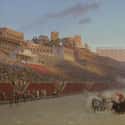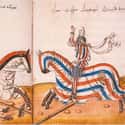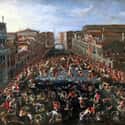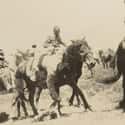-
(#1) Seminole Indians Wrestled Alligators For Food And Sport
Before Europeans settled in what is now known as Florida, Seminole Indians were already wrestling alligators for sport. Drawings from centuries ago show Seminoles leaping on alligators to slay them.
Sometimes, alligator wrestling was a way to get food. Other times, the sport was a way to celebrate the tribe. According to one story, a visitor on the Tamiami Trail saw a Seminole man capture an alligator and tie it up with his bare hands. The visitor gave the alligator wrestler money, saying, "It makes for a great show."
Alligator wrestling was certainly an extreme sport - the creatures are aggressive by nature, and challenging them to a wrestling match definitely raises the stakes.
-
(#2) Mayans Played A Ball Game Where The Losing Team Was Sometimes Sacrificed
Who created the first organized game in sports history? The Olmecs of Mesoamerica invented a ball game 3,500 years ago.
Teams faced off on a narrow strip between two sloped walls. Players had to keep a rubber ball in the air without touching it with their feet or hands. In the 13th century, many courts added a stone circle. If a player managed to hit the ball through the circle, their team automatically won the match.
But the game was about more than throwing a ball through a stone ring. It was also part of Olmec and Mayan rituals. For regular performances, crowds would gather to watch players compete, perhaps placing bets on the winning team. But ritual performances of the game were played for much higher stakes.
The Mayans sometimes forced prisoners of war to play the ball game, and members of the losing team would become sacrificial victims for the gods.
How popular was the game? Archaeologists have counted 1,300 ball courts in Mesoamerica, and most Mayan cities had at least one court.
-
(#3) Pankration Was An Ancient Greek Proto-MMA Sport Where Groin Kicks Were Totally Legit
The Greeks mixed boxing and wrestling in the ancient sport called pankration. Athletes competed in the sport during the ancient Olympic games, showing off their strength and stamina.
Although participants weren't armed, the sport was dangerous. With almost no restrictions on fighting, pankration matches quickly became more like war than a sport. Combatants could kick each other in the genitals or even bite off a rival's nose as long as they struck outside the ring.
Take Arrhichion of Phigalia, a popular athlete who won an Olympic medal but perished during his match. While his opponent tried to strangle him, Arrhichion broke the man's ankle. For another example, look to the athlete called "Fingertips," who got his nickname because he started each match by breaking his opponent's fingers.
Never one to walk away from a brutal sport, the Romans adopted pankration and made it even more dangerous by outfitting the fighters with spiked gloves.
-
(#4) Roman Chariot Racing Was Every Bit As Intense As ‘Ben-Hur’ Portrayed
Romans loved their extreme sports, and the sport that brought in the biggest crowds was chariot racing. When the Romans held a chariot race as the Circus Maximus, close to 200,000 fans watched.
During a chariot race, teams would compete against each other for the victory. Usually, 12 chariots lined up to battle it out, divided into four factions. Fans rooted for the team by showing off their color: red, blue, white, or green.
Like an ancient NASCAR race, Roman chariot races frequently featured crashes. As teams whipped around the curved arena, chariots tipped and horses ran into each other. The Romans called these crashes "shipwrecks."
Chariot racing was dangerous in part because drivers didn't have to follow rules. They were allowed to whip their rivals, toss them from their chariots, or trample fallen riders with their horses.
-
(#5) Jousting Was An Incredibly Dangerous Sport That Ended A French King And Ruined Henry VIII’s Life
Jousting might seem like a pleasant pastime for medieval noblemen, but the sport had major consequences for several royal families.
In 1536, King Henry VIII fell from his horse during a jousting match. The armored horse then fell on top of the king. The king lay unconscious for hours, and many feared he would perish. Though Henry recovered, he suffered from a leg injury that would cause him to gain weight and ultimately change his personality.
In fact, one theory claims the monarch suffered from a traumatic brain injury that made him erratic and paranoid. Just months after the accident, Henry turned against his second wife, Anne Boleyn, and sent her to the chopping block.
What made jousting so dangerous? Armored riders charged at each other, pointing wooden lances at their enemy. When the riders clashed, injuries were almost guaranteed.
And Henry wasn't the only royal victim of jousting. King Henry II of France perished after a jousting accident.
-
(#6) The Ancient Spartan Krypteia Was A Way For Teens To Practice Their Dangerous Skills On Slaves
Ancient Spartans trained from a young age in the art of war. But the most brutal training came during the krypteia, a bloody test for Spartan teenagers.
Spartan boys trained from a young age in military barracks where they were often beaten to toughen them up. Their final test as a teenager involved viciously executing unarmed slaves.
Boys would take a dagger and sneak into the countryside after sunset, hiding until they leaped out at unarmed slaves. Plato called the practice "a wonderfully severe training," since it taught young Spartans to prize brutality above all else. In Sparta, the slaves drastically outnumbered the citizens, and the krypteia was meant to keep the slaves terrified.
-
(#7) In Venice, Fighters Participated In Massive Bridge Battles
Medieval Venice had a lot of bridges, and its inhabitants liked to meet on those bridges for massive, all-out bridge battles.
Working-class Venetians would meet up at a bridge to fight it out. Some battles featured wooden sticks or canes. And every battle saw Venetians trying to shove their rivals off the bridge.
The competition was brutal. One witness recorded “scratches, sprains, teeth knocked out, dislocated jaws, gouged eyes, and finally, smashed ribs and crippled legs.”
The Venetians were so proud of their bridge battles that they held competitions to impress a group of Ottoman diplomats and Japanese ambassadors. When King Henry III witnessed a battle, he declared it "too small to be a real war and too cruel to be a game.”
-
(#8) Ancient Minoans Would Leap Onto The Backs Of Live Bulls
Ancient Minoans worshipped bulls, and may have sacrificed the animal as part of their religious rituals. They also practiced the dangerous game of bull leaping, in which they flipped onto the backs of wild bulls.
On the island of Crete, Minoans impressed crowds by grabbing a bull's horns, leaping onto its back, and flipping over the bull to land on the ground. Unlike later sports involving bulls, the Minoans did not slay the animal. Instead, the sport was a way to show off courage and daring.
One scholar believes high-status men would display their skills by leaping over bulls. Another theory argues that bull-jumpers were specialized athletes who practiced their trade in the ancient city of Knossos.
-
(#9) In North America, 1,000 Players Took The Field At Once To Play Pasuckuakohowog
In the 17th century, the Algonquins enjoyed playing a game called pasuckuakohowog, or "they gather to play ball with the foot." The soccer-like game was played on a massive field, with goals sometimes a mile apart from each other. As many as 1,000 players would flood the field to kick a ball through the goal.
There were no rules about headers, kicks, or fouls, so players often violently clashed during matches. After some matches, players walked away with broken bones. However, when it was all over, both sides typically celebrated with a feast.
-
(#10) Tewaarathon Was An Epic Proto-Lacrosse Match With Hundreds Of Players On A Field A Mile Long
The Iroquois Nation played a proto-lacrosse game called tewaarathon for centuries. The name, which means "little brother of war," was a way for warriors to practice their skills in between battles. The Iroquois also played tewaarathon to solve disputes.
Players lined up on a massive field. In some matches, as many as 1,000 players joined the game. The shortest fields were as long as four football fields, and the longest field might stretch across several miles.
Competitors used sticks with nets on the end to catch a deerskin ball, and the athletic game drove warriors to their physical limits.
-
(#11) Harpastum Was An Ancient Roman Ball Game That Was Like Football Mashed Up With Wrestling
The Romans played an ancient game called harpastum, where players tossed a ball on a field divided into two sides. But harpastum wasn't just an ancient version of football. Instead, players were allowed to attack each other during the match.
During a game, around 12 players competed in each team. They would line up on a field and try to keep the ball on their half of the field for the longest time. The ancient keep-away game often became violent.
Romans tackled each other with wrestling holds during harpastum matches. According to records, players often walked away from a game with injuries, including broken bones.
-
(#12) Buzkashi Is A Central Asian Polo Variant In Which The ‘Ball’ Is A Goat Carcass
In Afghanistan, centuries of players have taken the field for the game of buzkashi. At first glance, the sport seems like polo. But instead of fighting over a ball, players battle it out to grab a goat carcass.
Before a match, competitors prepared the goat in a very specific manner. The goat was decapitated and disemboweled. Players didn't group together in teams. Instead, it was every rider for himself. Whichever horseman managed to grab the carcass and carry it into a specially-defined end zone won.
“I found it so brutal - I mean, they are playing with the dead body of an animal,” said Spanish photographer Anna Huix when she witnessed a match. “Then again, I’m from Spain, where we have bullfighting. So many of our traditions seem to involve making animals suffer.”
-
(#13) Ancient Egyptians Battled It Out During Fisherman Jousting - And Tossed Rivals Into The Nile River
For ancient Egyptians, the Nile River was a water source, a means of transportation, and a bringer of fertile silt. The Nile was also where Egyptians played the dangerous game called "fisherman jousting."
Here's how they played: Fishermen piled into boats and sailed out on the Nile. Two boats approached each other, and the fishermen swiped at each other with the poles they used to push their boats.
Fisherman jousting dates back to the time of the pyramids. Rather than regularly staged competitions, it seems like the Egyptians fought on the spur of the moment. Some fights might have been to keep others out of fishing territories claimed by fishermen.
How did you win fisherman jousting? Easy - just knock your rival into the river. That sometimes proved dangerous, however, since some Egyptian fishermen couldn't swim.
New Random Displays Display All By Ranking
About This Tool
Our data comes from Ranker, If you want to participate in the ranking of items displayed on this page, please click here.























